2024年课标版高考英语第二轮专题练习--完形填空 文体分类练4 说明文和议论文(含答案与解析)
文档属性
| 名称 | 2024年课标版高考英语第二轮专题练习--完形填空 文体分类练4 说明文和议论文(含答案与解析) | 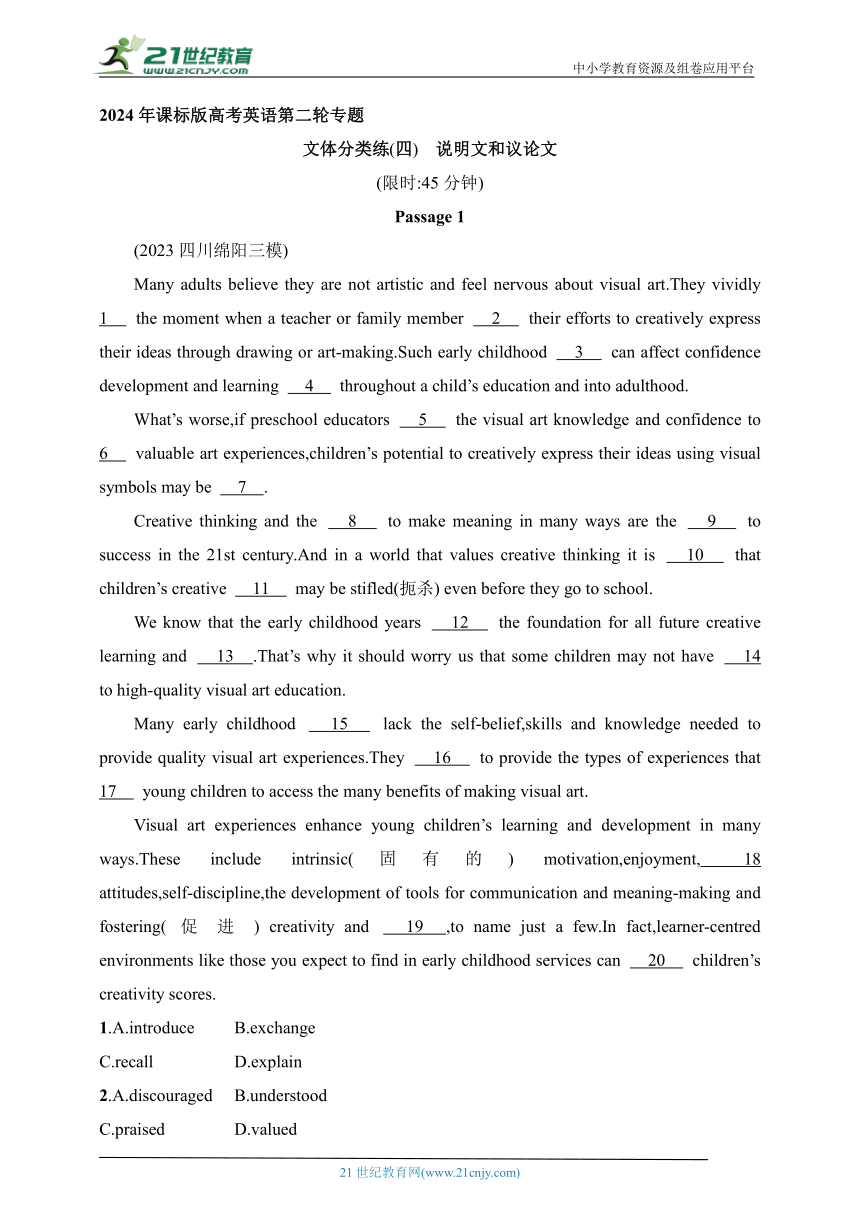 | |
| 格式 | docx | ||
| 文件大小 | 1.0MB | ||
| 资源类型 | 试卷 | ||
| 版本资源 | 通用版 | ||
| 科目 | 英语 | ||
| 更新时间 | 2023-11-03 12:49:16 | ||
图片预览

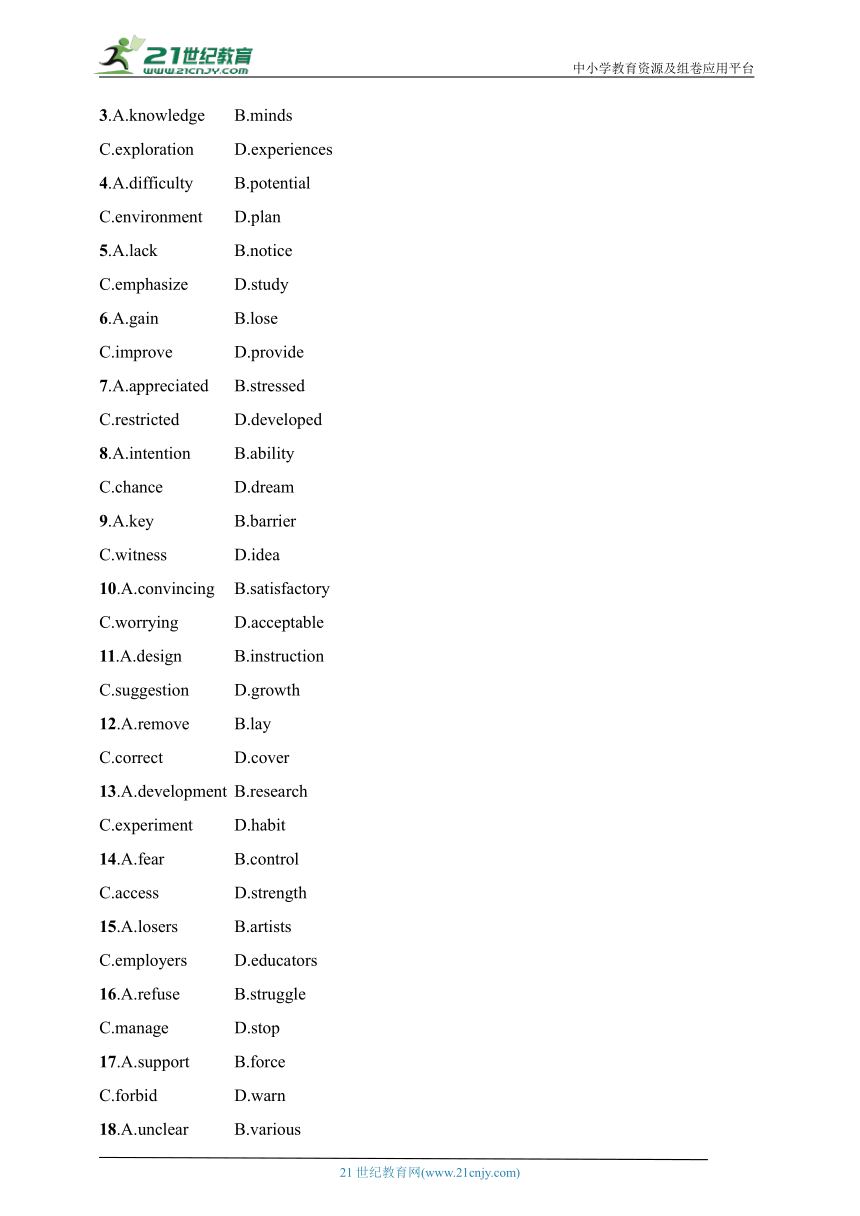
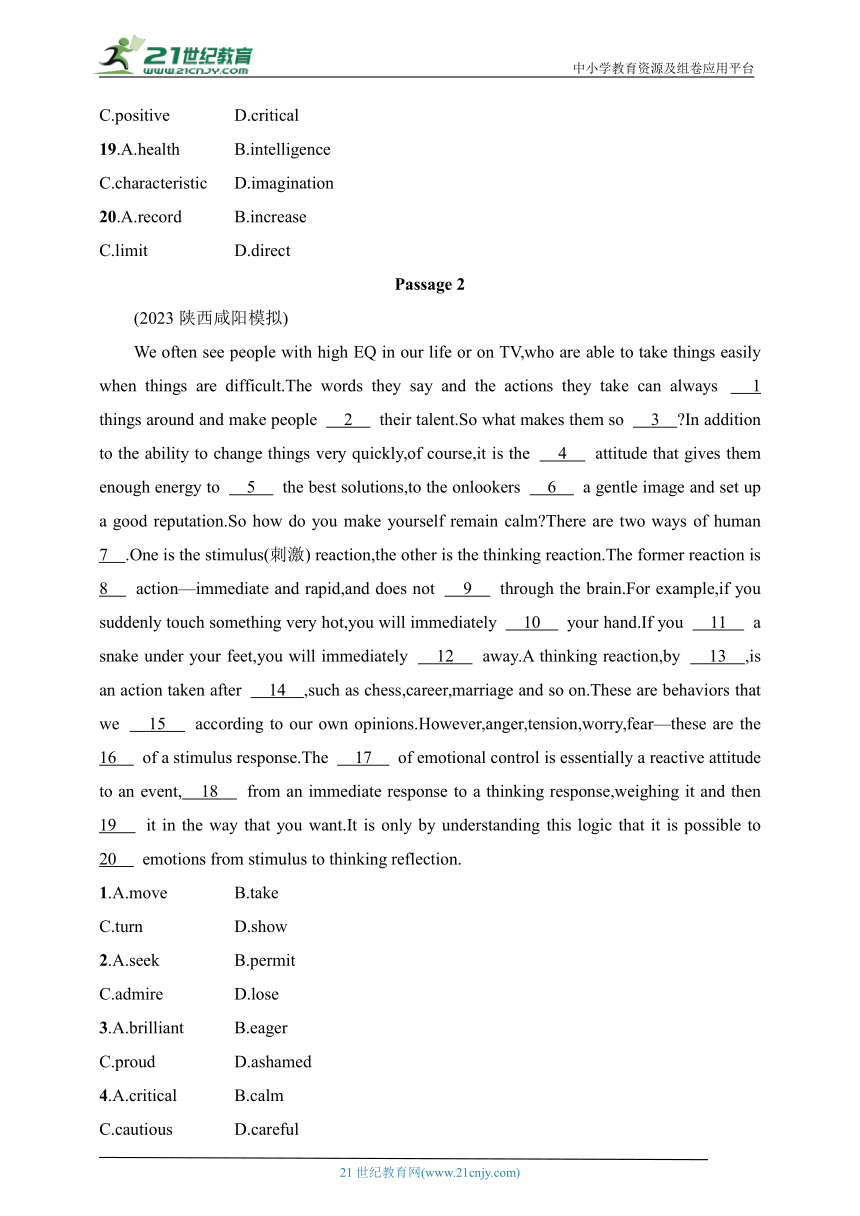
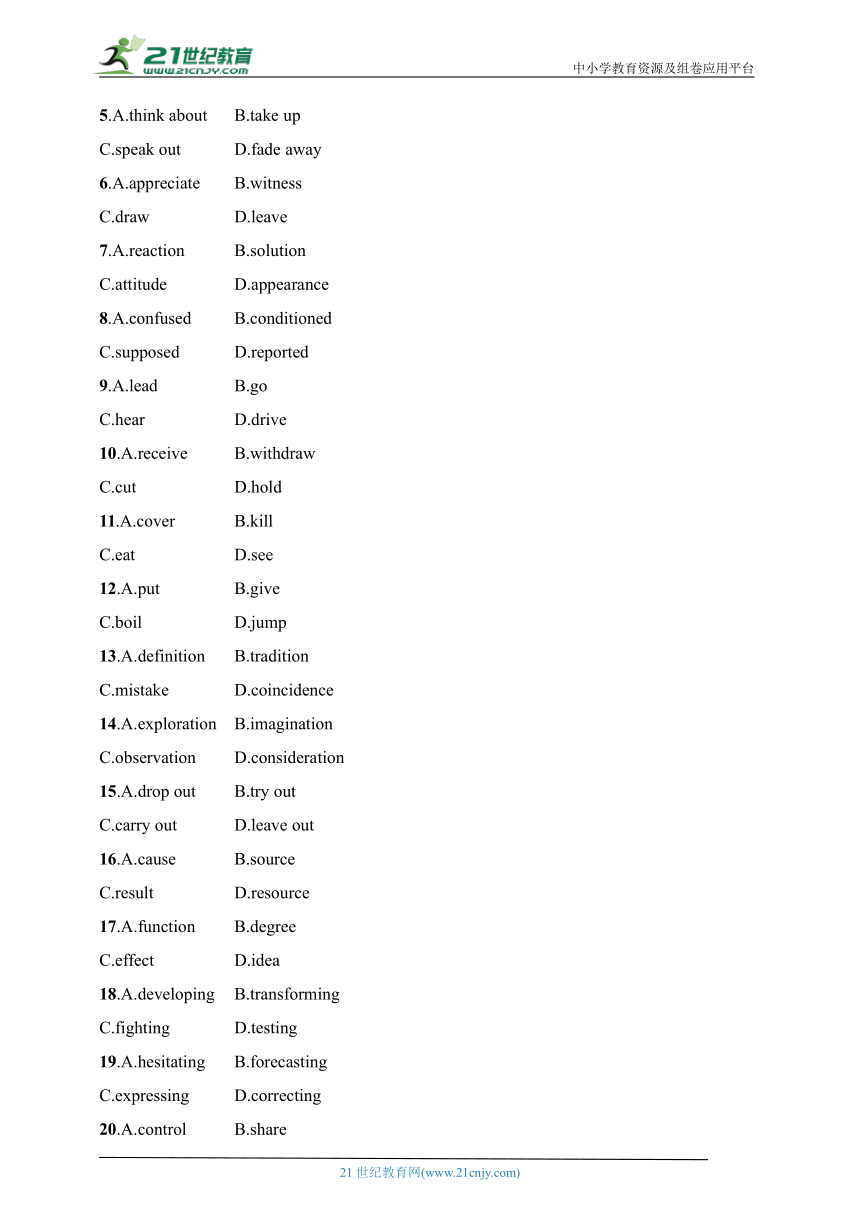
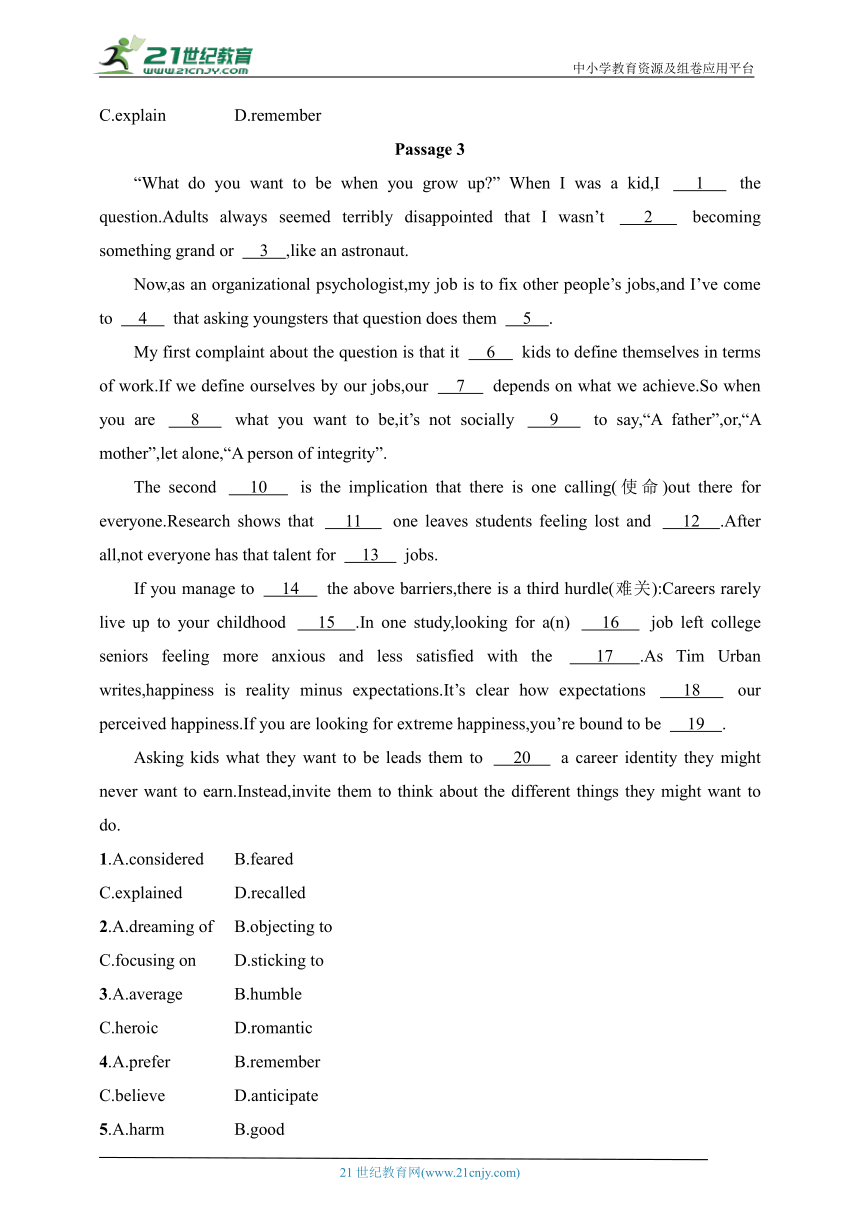
文档简介
中小学教育资源及组卷应用平台
2024年课标版高考英语第二轮专题
文体分类练(四) 说明文和议论文
(限时:45分钟)
Passage 1
(2023四川绵阳三模)
Many adults believe they are not artistic and feel nervous about visual art.They vividly 1 the moment when a teacher or family member 2 their efforts to creatively express their ideas through drawing or art-making.Such early childhood 3 can affect confidence development and learning 4 throughout a child’s education and into adulthood.
What’s worse,if preschool educators 5 the visual art knowledge and confidence to 6 valuable art experiences,children’s potential to creatively express their ideas using visual symbols may be 7 .
Creative thinking and the 8 to make meaning in many ways are the 9 to success in the 21st century.And in a world that values creative thinking it is 10 that children’s creative 11 may be stifled(扼杀) even before they go to school.
We know that the early childhood years 12 the foundation for all future creative learning and 13 .That’s why it should worry us that some children may not have 14 to high-quality visual art education.
Many early childhood 15 lack the self-belief,skills and knowledge needed to provide quality visual art experiences.They 16 to provide the types of experiences that 17 young children to access the many benefits of making visual art.
Visual art experiences enhance young children’s learning and development in many ways.These include intrinsic(固有的) motivation,enjoyment, 18 attitudes,self-discipline,the development of tools for communication and meaning-making and fostering( 促 进 ) creativity and 19 ,to name just a few.In fact,learner-centred environments like those you expect to find in early childhood services can 20 children’s creativity scores.
1.A.introduce B.exchange
C.recall D.explain
2.A.discouraged B.understood
C.praised D.valued
3.A.knowledge B.minds
C.exploration D.experiences
4.A.difficulty B.potential
C.environment D.plan
5.A.lack B.notice
C.emphasize D.study
6.A.gain B.lose
C.improve D.provide
7.A.appreciated B.stressed
C.restricted D.developed
8.A.intention B.ability
C.chance D.dream
9.A.key B.barrier
C.witness D.idea
10.A.convincing B.satisfactory
C.worrying D.acceptable
11.A.design B.instruction
C.suggestion D.growth
12.A.remove B.lay
C.correct D.cover
13.A.development B.research
C.experiment D.habit
14.A.fear B.control
C.access D.strength
15.A.losers B.artists
C.employers D.educators
16.A.refuse B.struggle
C.manage D.stop
17.A.support B.force
C.forbid D.warn
18.A.unclear B.various
C.positive D.critical
19.A.health B.intelligence
C.characteristic D.imagination
20.A.record B.increase
C.limit D.direct
Passage 2
(2023陕西咸阳模拟)
We often see people with high EQ in our life or on TV,who are able to take things easily when things are difficult.The words they say and the actions they take can always 1 things around and make people 2 their talent.So what makes them so 3 In addition to the ability to change things very quickly,of course,it is the 4 attitude that gives them enough energy to 5 the best solutions,to the onlookers 6 a gentle image and set up a good reputation.So how do you make yourself remain calm There are two ways of human 7 .One is the stimulus(刺激) reaction,the other is the thinking reaction.The former reaction is 8 action—immediate and rapid,and does not 9 through the brain.For example,if you suddenly touch something very hot,you will immediately 10 your hand.If you 11 a snake under your feet,you will immediately 12 away.A thinking reaction,by 13 ,is an action taken after 14 ,such as chess,career,marriage and so on.These are behaviors that we 15 according to our own opinions.However,anger,tension,worry,fear—these are the 16 of a stimulus response.The 17 of emotional control is essentially a reactive attitude to an event, 18 from an immediate response to a thinking response,weighing it and then 19 it in the way that you want.It is only by understanding this logic that it is possible to 20 emotions from stimulus to thinking reflection.
1.A.move B.take
C.turn D.show
2.A.seek B.permit
C.admire D.lose
3.A.brilliant B.eager
C.proud D.ashamed
4.A.critical B.calm
C.cautious D.careful
5.A.think about B.take up
C.speak out D.fade away
6.A.appreciate B.witness
C.draw D.leave
7.A.reaction B.solution
C.attitude D.appearance
8.A.confused B.conditioned
C.supposed D.reported
9.A.lead B.go
C.hear D.drive
10.A.receive B.withdraw
C.cut D.hold
11.A.cover B.kill
C.eat D.see
12.A.put B.give
C.boil D.jump
13.A.definition B.tradition
C.mistake D.coincidence
14.A.exploration B.imagination
C.observation D.consideration
15.A.drop out B.try out
C.carry out D.leave out
16.A.cause B.source
C.result D.resource
17.A.function B.degree
C.effect D.idea
18.A.developing B.transforming
C.fighting D.testing
19.A.hesitating B.forecasting
C.expressing D.correcting
20.A.control B.share
C.explain D.remember
Passage 3
“What do you want to be when you grow up ” When I was a kid,I 1 the question.Adults always seemed terribly disappointed that I wasn’t 2 becoming something grand or 3 ,like an astronaut.
Now,as an organizational psychologist,my job is to fix other people’s jobs,and I’ve come to 4 that asking youngsters that question does them 5 .
My first complaint about the question is that it 6 kids to define themselves in terms of work.If we define ourselves by our jobs,our 7 depends on what we achieve.So when you are 8 what you want to be,it’s not socially 9 to say,“A father”,or,“A mother”,let alone,“A person of integrity”.
The second 10 is the implication that there is one calling(使命)out there for everyone.Research shows that 11 one leaves students feeling lost and 12 .After all,not everyone has that talent for 13 jobs.
If you manage to 14 the above barriers,there is a third hurdle(难关):Careers rarely live up to your childhood 15 .In one study,looking for a(n) 16 job left college seniors feeling more anxious and less satisfied with the 17 .As Tim Urban writes,happiness is reality minus expectations.It’s clear how expectations 18 our perceived happiness.If you are looking for extreme happiness,you’re bound to be 19 .
Asking kids what they want to be leads them to 20 a career identity they might never want to earn.Instead,invite them to think about the different things they might want to do.
1.A.considered B.feared
C.explained D.recalled
2.A.dreaming of B.objecting to
C.focusing on D.sticking to
3.A.average B.humble
C.heroic D.romantic
4.A.prefer B.remember
C.believe D.anticipate
5.A.harm B.good
C.wrong D.honor
6.A.forces B.troubles
C.commands D.forbids
7.A.status B.experience
C.worth D.fame
8.A.taught B.asked
C.guided D.consulted
9.A.rejected B.accurate
C.confirmed D.acceptable
10.A.thought B.division
C.assumption D.problem
11.A.picking up B.searching for
C.praying for D.taking over
12.A.bored B.impatient
C.intolerant D.confused
13.A.grand B.boring
C.tough D.beneficial
14.A.strengthen B.control
C.build D.overcome
15.A.efforts B.struggles
C.ambitions D.gains
16.A.ideal B.permanent
C.ordinary D.specific
17.A.benefit B.outcome
C.solution D.truth
18.A.boost B.contain
C.guarantee D.affect
19.A.disappointed B.addicted
C.delighted D.embarrassed
20.A.refuse B.claim
C.keep D.ignore
答案:
Passage 1
[语篇解读]本文是一篇说明文。全文首先分析了儿童视觉艺术认识的缺乏,包括父母和老师的限制,以及学前教育老师视觉艺术技能的缺乏等,然后讲述视觉艺术对儿童成长的重要影响。
1.C 根据下文“Such early childhood”可知,空后的内容是成年人对儿时的回忆。故选C项。
2.A 根据下文“can affect confidence development and learning”以及其他讲述可知,老师和家庭成员没有鼓励孩子通过绘画或其他艺术形式实现他们创造性的表达。故选A项。
3.D 根据上文“the moment when a teacher or family member”可知,作者讲述人们儿时的经历。故选D项。
4.B 根据空后的“throughout a child’s education and into adulthood”可知,作者在此讲述学习潜力。故选B项。
5.A 根据下文“may be ”可知,因为老师缺乏视觉艺术知识和信心,学生的创造力就受到了限制。故选A项。
6.D 根据空后的“valuable art experiences”可知,因为老师缺乏视觉艺术知识,他们不能提供给孩子们宝贵的艺术体验。故选D项。
7.C 根据上文的“through drawing or art-making”可知,作者把孩子们的绘画看成是视觉符号,但是因为学前教育工作者缺乏经验,因此孩子潜力可能会受限。故选C项。
8.B 根据空后的“to make meaning in many ways”可以推断,作者在此讲述以多种方式表达意思的能力。故选B项。
9.A 根据上下文以及空后的“to success in the 21st century”可知,作者充分肯定了创造性思维和多种方式表达意思的重要性,因此说是21世纪成功的关键。故选A项。
10.C 根据下文的“may be stifled”可知,孩子们的视觉艺术能力甚至在上学前就被扼杀,这是令人担忧的。故选C项。
11.D 根据空前的“children’s creative”可知,作者在此讲述孩子们的创造性思维,也就是创造性的成长。故选D项。
12.B 根据空前的“the early childhood years”和空后的“the foundation for all future creative learning”可知,孩子们早年时光为未来的创造性思维打下基础。故选B项。
13.A 上文讲述孩子们的创造性成长,因此此处讲述孩子们的创造性发展。故选A项。
14.C 根据空前的“That’s why it should worry us”可知,孩子们可能没法获取高质量的视觉艺术教育。故选C项。
15.D 根据上文的“That’s why it should worry us that some children may not have to high-quality visual art education.”可知,此处,作者分析孩子不能接受高质量的视觉艺术教育的原因是,有些儿童教育从教者缺乏自信、技术和知识。故选D项。
16.B 根据空前的“lack the self-belief...”可知,因为他们缺乏视觉艺术的知识,他们很难提供给孩子们各种体验。故选B项。
17.A 根据空后的“young children to access the many benefits of making visual art”可知,他们在给孩子们制造视觉艺术的方面很难给予支持。故选A项。
18.C 根据空前的“enhance young children’s learning and development”可知,视觉艺术可以培养孩子积极的态度。故选C项。
19.D 根据空前的“creativity”以及上文讲述可知,视觉艺术可以激发孩子的想象力。故选D项。
20.B 根据空后的“children’s creativity scores”可知,视觉艺术的另一个好处就是增加孩子创造力的分数。故选B项。
Passage 2
[语篇解读]本文是一篇说明文。文章主要介绍了高情商的人是如何在面对困境时让自己变得冷静下来并应付这种局面的。
1.C 根据上文“We often see people with high EQ in our life or on TV,who are able to take things easy when things are difficult.”可知,那些高情商的人能让困难的事情变得简单化。也就是说他们能扭转局面,turn things around表示扭转局面,符合题意。故选C项。
2.C 根据上文“The words they say and the actions they take can always things around”可知,他们可以扭转不好的局面,这是让别人羡慕的才华。故选C项。
3.A 根据下文“In addition to the ability to change things very quickly,of course,it is attitude that gives them enough energy to the best solutions”可知,他们应对事情的速度和态度让他们有了最好的解决办法。从而可以知道这些人很优秀。故选A项。
4.B 根据下文“So how do you make yourself remain calm ”可知,我们需要让自己变得冷静下来,所以那些高情商的人面对事情的态度是冷静的,我们也需要如此。故选B项。
5.A 根据上文“it is the attitude that gives them enough energy”可知,冷静的态度让他们有了足够的精力,从而就能想出好的解决办法。故选A项。
6.D 根据下文“set up a good reputation”可知,他们给旁观者树立了好的名誉,同时留下了好的形象。D项符合题意。故选D项。
7.A 根据下文“One is the stimulus reaction,the other is the thinking reaction.”可知,一种是刺激反应,另一种是思考反应。下文提到的两种反应方式就是这里的两种反应方式。故选A项。
8.B 根据下文“and does not through the brain”可知,这种反应是不经过大脑的反应方式,也就是根据情况立马做出的反应。故选B项。
9.B go through表示经过、通过,这里表示事情不经过大脑就做出反应,符合题意。故选B项。
10.B 突然碰到烫的东西我们会缩手,这是本能反应。故选B项。
11.D 根据下文“you will immediately away”可知,我们会立刻走开,因为脚下看到了蛇。D项符合题意。故选D项。
12.D 根据上文“If you a snake under your feet”可知,脚下看到了蛇,肯定要走开,这是人的正常反应。故选D项。
13.A by definition为固定短语,表示根据定义,a thinking reaction字面意思就是考虑后再行动,符合题意。故选A项。
14.D “is an action taken after”用来解释主语“A thinking reaction”,字面意思为思考反应,D项consideration表示考虑,跟主语意思一致。故选D项。
15.C 上文“A thinking reaction,by ,is an action taken after”中的take action和C选项中的 carry out都表示做出这一行为。故选C项。
16.C 上文“However,anger,tension,worry,fear”都是刺激反应的结果,即前者是后者造成的结果。故选C项。
17.D 根据下文“it is possible to emotions from stimulus to thinking reflection”可知,只有明白了这个道理才能……。这里logic和idea是同一个意思,表示理念,逻辑。故选D项。
18.B 根据下文“weighing it and then it in the way that you want”可知,要把直接理念转为思考理念。故选B项。
19.C 考量这个问题后要以自己想要的方式表达出来。故选C项。
20.A 从刺激反应到思考反应是因为控制了情绪。故选A项。
Passage 3
[语篇解读]本文是一篇议论文。询问孩子长大之后想成为什么对孩子有害。文章论述了三方面的害处。作者建议,邀请孩子想想他们可能想做的其他事情。
1.B 根据下文中的“Adults always seemed terribly disappointed that I wasn’t becoming something grand or ,like an astronaut.” 可知,成年人对作者的回答总是感到失望。所以作者很害怕被问到这个问题。他的回答让成年人不满意。故选B项。
2.A 根据上文中的“What do you want to be when you grow up ”可知,该处提到的是作者长大之后的梦想。故选A项。
3.C 根据下文中的“like an astronaut”可知,宇航员属于伟大的或英雄般的人物。故选C项。
4.C 根据后面的“that asking youngsters that question does them ”可知,这是作者作为心理学家的观点或看法。他认为问年轻人这个问题会伤害他们。故选C项。
5.A 根据下文中的“My first complaint about the question”可知,作者对这个问题心存抱怨。由此推知,这个问题对孩子们来说并不好,会对他们会造成伤害。故选A项。
6.A 结合上一题的解析和空前的“My first complaint about the question”可知,这个问题对孩子们有害。当问孩子们长大之后的梦想的时候,孩子们就被迫从工作角度来定义自己。故选A项。
7.C 根据上文“If we define ourselves by our jobs”可以推知,如果我们用工作来定义自己,那么我们在工作中取得的成就决定了我们的个人价值。工作好,成就高,个人价值就高。反之,工作不好,成就低,个人价值就低。故选C项。
8.B 根据上文中的“asking youngsters that question does them ”可知,孩子们被问到想成为一个什么人。故选B项。
9.D 根据上文“it kids to define themselves in terms of work.If we define ourselves by our jobs,our depends on what we achieve”可知,当用工作来定义一个人的时候,个人价值取决于个人成就。所以,诸如“成为一个父亲”“成为一个母亲”或“成为一个正直的人”这样和工作毫无关系的回答显然是不符合期望,不被接受的。故选D项。
10.D 结合上文中的“My first complaint about the question”和下文中的“If you manage to the above barriers,there is a third hurdle”可知,第二、三、四段探讨的都是问孩子长大后要成为什么人产生的害处。因此,该空应该选择一个贬义词,表示询问孩子这个问题所产生的问题或害处。故选D项。
11.B 根据下文中的“not everyone has that talent for jobs”可知,对伟大使命的寻求会让学生感到迷惑。故选B项。
12.D 该空和lost并列,意思应该和lost接近。结合上题解析可知,对伟大使命的寻求让学生迷失和困惑。故选D项。
13.A 根据上文“Adults always seemed terribly disappointed that I wasn’t becoming something grand or ,like an astronaut.” 可知,并不是人人都有做伟大工作的天分。故选A项。
14.D 根据空前的“manage to”和后面的“there is a third hurdle”可知,该处应该指即使你可以克服前面提到的两个障碍,还有一个障碍你无法克服。故选D项。
15.C 根据上文提到的问题“What do you want to be when you grow up ”可知,孩子们小时候经常被问到自己长大后的理想。但是长大之后做的职业很难实现童年的理想,即童年的雄心壮志。故选C项。
16.A 根据后面的“left college seniors feeling more anxious and less satisfied”可知,大四学生都想找一份理想的工作。但是找理想的工作不容易,所以他们焦虑、不满意。故选A项。
17.B 根据上文的“Careers rarely live up to your childhood .”可知,大四学生找不到理想工作,无法实现童年的梦想,学生们对这样的结果感到焦虑、不满意。故选B项。
18.D 根据上文中的“happiness is reality minus expectations”可知,现实总是和期望有差距。因此,期望值过高,实现不了,就会影响幸福感。故选D项。
19.A 结合上一题的解析以及“If you are looking for extreme happiness”可知,期望会影响幸福感。极度的幸福是不可能实现的。由此推知,如果你寻找极度的幸福,那么你肯定实现不了,你肯定会失望。故选A项。
20.B 上文介绍了问“孩子他们想成为什么”这个问题所产生的三方面危害。由此推知,问孩子这个问题会导致孩子获得一种他们可能永远都不想获得的职业身份。该空和后面的earn一致。故选B项。
词汇积累:
1.(Passage 1)enhance young children’s learning加强幼儿学习
2.(Passage 1)to name just a few仅举几个例子
3.(Passage 2)leave a gentle image留下温和的形象
4.(Passage 2)set up a good reputation树立良好声誉
5.(Passage 2)withdraw your hand 缩回你的手
6.(Passage 3)seem terribly disappointed看起来非常失望
7.(Passage 3)in terms of work就工作而言
8.(Passage 3)live up to your childhood ambitions不辜负你儿时的雄心壮志
9.(Passage 3)be bound to be disappointed 一定会失望
经典句型
(Passage 2)It is only by understanding this logic that it is possible to control emotions from stimulus to thinking reflection.
只有理解了这个逻辑才能控制情绪从刺激反应转为思考反应。
21世纪教育网 www.21cnjy.com 精品试卷·第 2 页 (共 2 页)
21世纪教育网(www.21cnjy.com)
2024年课标版高考英语第二轮专题
文体分类练(四) 说明文和议论文
(限时:45分钟)
Passage 1
(2023四川绵阳三模)
Many adults believe they are not artistic and feel nervous about visual art.They vividly 1 the moment when a teacher or family member 2 their efforts to creatively express their ideas through drawing or art-making.Such early childhood 3 can affect confidence development and learning 4 throughout a child’s education and into adulthood.
What’s worse,if preschool educators 5 the visual art knowledge and confidence to 6 valuable art experiences,children’s potential to creatively express their ideas using visual symbols may be 7 .
Creative thinking and the 8 to make meaning in many ways are the 9 to success in the 21st century.And in a world that values creative thinking it is 10 that children’s creative 11 may be stifled(扼杀) even before they go to school.
We know that the early childhood years 12 the foundation for all future creative learning and 13 .That’s why it should worry us that some children may not have 14 to high-quality visual art education.
Many early childhood 15 lack the self-belief,skills and knowledge needed to provide quality visual art experiences.They 16 to provide the types of experiences that 17 young children to access the many benefits of making visual art.
Visual art experiences enhance young children’s learning and development in many ways.These include intrinsic(固有的) motivation,enjoyment, 18 attitudes,self-discipline,the development of tools for communication and meaning-making and fostering( 促 进 ) creativity and 19 ,to name just a few.In fact,learner-centred environments like those you expect to find in early childhood services can 20 children’s creativity scores.
1.A.introduce B.exchange
C.recall D.explain
2.A.discouraged B.understood
C.praised D.valued
3.A.knowledge B.minds
C.exploration D.experiences
4.A.difficulty B.potential
C.environment D.plan
5.A.lack B.notice
C.emphasize D.study
6.A.gain B.lose
C.improve D.provide
7.A.appreciated B.stressed
C.restricted D.developed
8.A.intention B.ability
C.chance D.dream
9.A.key B.barrier
C.witness D.idea
10.A.convincing B.satisfactory
C.worrying D.acceptable
11.A.design B.instruction
C.suggestion D.growth
12.A.remove B.lay
C.correct D.cover
13.A.development B.research
C.experiment D.habit
14.A.fear B.control
C.access D.strength
15.A.losers B.artists
C.employers D.educators
16.A.refuse B.struggle
C.manage D.stop
17.A.support B.force
C.forbid D.warn
18.A.unclear B.various
C.positive D.critical
19.A.health B.intelligence
C.characteristic D.imagination
20.A.record B.increase
C.limit D.direct
Passage 2
(2023陕西咸阳模拟)
We often see people with high EQ in our life or on TV,who are able to take things easily when things are difficult.The words they say and the actions they take can always 1 things around and make people 2 their talent.So what makes them so 3 In addition to the ability to change things very quickly,of course,it is the 4 attitude that gives them enough energy to 5 the best solutions,to the onlookers 6 a gentle image and set up a good reputation.So how do you make yourself remain calm There are two ways of human 7 .One is the stimulus(刺激) reaction,the other is the thinking reaction.The former reaction is 8 action—immediate and rapid,and does not 9 through the brain.For example,if you suddenly touch something very hot,you will immediately 10 your hand.If you 11 a snake under your feet,you will immediately 12 away.A thinking reaction,by 13 ,is an action taken after 14 ,such as chess,career,marriage and so on.These are behaviors that we 15 according to our own opinions.However,anger,tension,worry,fear—these are the 16 of a stimulus response.The 17 of emotional control is essentially a reactive attitude to an event, 18 from an immediate response to a thinking response,weighing it and then 19 it in the way that you want.It is only by understanding this logic that it is possible to 20 emotions from stimulus to thinking reflection.
1.A.move B.take
C.turn D.show
2.A.seek B.permit
C.admire D.lose
3.A.brilliant B.eager
C.proud D.ashamed
4.A.critical B.calm
C.cautious D.careful
5.A.think about B.take up
C.speak out D.fade away
6.A.appreciate B.witness
C.draw D.leave
7.A.reaction B.solution
C.attitude D.appearance
8.A.confused B.conditioned
C.supposed D.reported
9.A.lead B.go
C.hear D.drive
10.A.receive B.withdraw
C.cut D.hold
11.A.cover B.kill
C.eat D.see
12.A.put B.give
C.boil D.jump
13.A.definition B.tradition
C.mistake D.coincidence
14.A.exploration B.imagination
C.observation D.consideration
15.A.drop out B.try out
C.carry out D.leave out
16.A.cause B.source
C.result D.resource
17.A.function B.degree
C.effect D.idea
18.A.developing B.transforming
C.fighting D.testing
19.A.hesitating B.forecasting
C.expressing D.correcting
20.A.control B.share
C.explain D.remember
Passage 3
“What do you want to be when you grow up ” When I was a kid,I 1 the question.Adults always seemed terribly disappointed that I wasn’t 2 becoming something grand or 3 ,like an astronaut.
Now,as an organizational psychologist,my job is to fix other people’s jobs,and I’ve come to 4 that asking youngsters that question does them 5 .
My first complaint about the question is that it 6 kids to define themselves in terms of work.If we define ourselves by our jobs,our 7 depends on what we achieve.So when you are 8 what you want to be,it’s not socially 9 to say,“A father”,or,“A mother”,let alone,“A person of integrity”.
The second 10 is the implication that there is one calling(使命)out there for everyone.Research shows that 11 one leaves students feeling lost and 12 .After all,not everyone has that talent for 13 jobs.
If you manage to 14 the above barriers,there is a third hurdle(难关):Careers rarely live up to your childhood 15 .In one study,looking for a(n) 16 job left college seniors feeling more anxious and less satisfied with the 17 .As Tim Urban writes,happiness is reality minus expectations.It’s clear how expectations 18 our perceived happiness.If you are looking for extreme happiness,you’re bound to be 19 .
Asking kids what they want to be leads them to 20 a career identity they might never want to earn.Instead,invite them to think about the different things they might want to do.
1.A.considered B.feared
C.explained D.recalled
2.A.dreaming of B.objecting to
C.focusing on D.sticking to
3.A.average B.humble
C.heroic D.romantic
4.A.prefer B.remember
C.believe D.anticipate
5.A.harm B.good
C.wrong D.honor
6.A.forces B.troubles
C.commands D.forbids
7.A.status B.experience
C.worth D.fame
8.A.taught B.asked
C.guided D.consulted
9.A.rejected B.accurate
C.confirmed D.acceptable
10.A.thought B.division
C.assumption D.problem
11.A.picking up B.searching for
C.praying for D.taking over
12.A.bored B.impatient
C.intolerant D.confused
13.A.grand B.boring
C.tough D.beneficial
14.A.strengthen B.control
C.build D.overcome
15.A.efforts B.struggles
C.ambitions D.gains
16.A.ideal B.permanent
C.ordinary D.specific
17.A.benefit B.outcome
C.solution D.truth
18.A.boost B.contain
C.guarantee D.affect
19.A.disappointed B.addicted
C.delighted D.embarrassed
20.A.refuse B.claim
C.keep D.ignore
答案:
Passage 1
[语篇解读]本文是一篇说明文。全文首先分析了儿童视觉艺术认识的缺乏,包括父母和老师的限制,以及学前教育老师视觉艺术技能的缺乏等,然后讲述视觉艺术对儿童成长的重要影响。
1.C 根据下文“Such early childhood”可知,空后的内容是成年人对儿时的回忆。故选C项。
2.A 根据下文“can affect confidence development and learning”以及其他讲述可知,老师和家庭成员没有鼓励孩子通过绘画或其他艺术形式实现他们创造性的表达。故选A项。
3.D 根据上文“the moment when a teacher or family member”可知,作者讲述人们儿时的经历。故选D项。
4.B 根据空后的“throughout a child’s education and into adulthood”可知,作者在此讲述学习潜力。故选B项。
5.A 根据下文“may be ”可知,因为老师缺乏视觉艺术知识和信心,学生的创造力就受到了限制。故选A项。
6.D 根据空后的“valuable art experiences”可知,因为老师缺乏视觉艺术知识,他们不能提供给孩子们宝贵的艺术体验。故选D项。
7.C 根据上文的“through drawing or art-making”可知,作者把孩子们的绘画看成是视觉符号,但是因为学前教育工作者缺乏经验,因此孩子潜力可能会受限。故选C项。
8.B 根据空后的“to make meaning in many ways”可以推断,作者在此讲述以多种方式表达意思的能力。故选B项。
9.A 根据上下文以及空后的“to success in the 21st century”可知,作者充分肯定了创造性思维和多种方式表达意思的重要性,因此说是21世纪成功的关键。故选A项。
10.C 根据下文的“may be stifled”可知,孩子们的视觉艺术能力甚至在上学前就被扼杀,这是令人担忧的。故选C项。
11.D 根据空前的“children’s creative”可知,作者在此讲述孩子们的创造性思维,也就是创造性的成长。故选D项。
12.B 根据空前的“the early childhood years”和空后的“the foundation for all future creative learning”可知,孩子们早年时光为未来的创造性思维打下基础。故选B项。
13.A 上文讲述孩子们的创造性成长,因此此处讲述孩子们的创造性发展。故选A项。
14.C 根据空前的“That’s why it should worry us”可知,孩子们可能没法获取高质量的视觉艺术教育。故选C项。
15.D 根据上文的“That’s why it should worry us that some children may not have to high-quality visual art education.”可知,此处,作者分析孩子不能接受高质量的视觉艺术教育的原因是,有些儿童教育从教者缺乏自信、技术和知识。故选D项。
16.B 根据空前的“lack the self-belief...”可知,因为他们缺乏视觉艺术的知识,他们很难提供给孩子们各种体验。故选B项。
17.A 根据空后的“young children to access the many benefits of making visual art”可知,他们在给孩子们制造视觉艺术的方面很难给予支持。故选A项。
18.C 根据空前的“enhance young children’s learning and development”可知,视觉艺术可以培养孩子积极的态度。故选C项。
19.D 根据空前的“creativity”以及上文讲述可知,视觉艺术可以激发孩子的想象力。故选D项。
20.B 根据空后的“children’s creativity scores”可知,视觉艺术的另一个好处就是增加孩子创造力的分数。故选B项。
Passage 2
[语篇解读]本文是一篇说明文。文章主要介绍了高情商的人是如何在面对困境时让自己变得冷静下来并应付这种局面的。
1.C 根据上文“We often see people with high EQ in our life or on TV,who are able to take things easy when things are difficult.”可知,那些高情商的人能让困难的事情变得简单化。也就是说他们能扭转局面,turn things around表示扭转局面,符合题意。故选C项。
2.C 根据上文“The words they say and the actions they take can always things around”可知,他们可以扭转不好的局面,这是让别人羡慕的才华。故选C项。
3.A 根据下文“In addition to the ability to change things very quickly,of course,it is attitude that gives them enough energy to the best solutions”可知,他们应对事情的速度和态度让他们有了最好的解决办法。从而可以知道这些人很优秀。故选A项。
4.B 根据下文“So how do you make yourself remain calm ”可知,我们需要让自己变得冷静下来,所以那些高情商的人面对事情的态度是冷静的,我们也需要如此。故选B项。
5.A 根据上文“it is the attitude that gives them enough energy”可知,冷静的态度让他们有了足够的精力,从而就能想出好的解决办法。故选A项。
6.D 根据下文“set up a good reputation”可知,他们给旁观者树立了好的名誉,同时留下了好的形象。D项符合题意。故选D项。
7.A 根据下文“One is the stimulus reaction,the other is the thinking reaction.”可知,一种是刺激反应,另一种是思考反应。下文提到的两种反应方式就是这里的两种反应方式。故选A项。
8.B 根据下文“and does not through the brain”可知,这种反应是不经过大脑的反应方式,也就是根据情况立马做出的反应。故选B项。
9.B go through表示经过、通过,这里表示事情不经过大脑就做出反应,符合题意。故选B项。
10.B 突然碰到烫的东西我们会缩手,这是本能反应。故选B项。
11.D 根据下文“you will immediately away”可知,我们会立刻走开,因为脚下看到了蛇。D项符合题意。故选D项。
12.D 根据上文“If you a snake under your feet”可知,脚下看到了蛇,肯定要走开,这是人的正常反应。故选D项。
13.A by definition为固定短语,表示根据定义,a thinking reaction字面意思就是考虑后再行动,符合题意。故选A项。
14.D “is an action taken after”用来解释主语“A thinking reaction”,字面意思为思考反应,D项consideration表示考虑,跟主语意思一致。故选D项。
15.C 上文“A thinking reaction,by ,is an action taken after”中的take action和C选项中的 carry out都表示做出这一行为。故选C项。
16.C 上文“However,anger,tension,worry,fear”都是刺激反应的结果,即前者是后者造成的结果。故选C项。
17.D 根据下文“it is possible to emotions from stimulus to thinking reflection”可知,只有明白了这个道理才能……。这里logic和idea是同一个意思,表示理念,逻辑。故选D项。
18.B 根据下文“weighing it and then it in the way that you want”可知,要把直接理念转为思考理念。故选B项。
19.C 考量这个问题后要以自己想要的方式表达出来。故选C项。
20.A 从刺激反应到思考反应是因为控制了情绪。故选A项。
Passage 3
[语篇解读]本文是一篇议论文。询问孩子长大之后想成为什么对孩子有害。文章论述了三方面的害处。作者建议,邀请孩子想想他们可能想做的其他事情。
1.B 根据下文中的“Adults always seemed terribly disappointed that I wasn’t becoming something grand or ,like an astronaut.” 可知,成年人对作者的回答总是感到失望。所以作者很害怕被问到这个问题。他的回答让成年人不满意。故选B项。
2.A 根据上文中的“What do you want to be when you grow up ”可知,该处提到的是作者长大之后的梦想。故选A项。
3.C 根据下文中的“like an astronaut”可知,宇航员属于伟大的或英雄般的人物。故选C项。
4.C 根据后面的“that asking youngsters that question does them ”可知,这是作者作为心理学家的观点或看法。他认为问年轻人这个问题会伤害他们。故选C项。
5.A 根据下文中的“My first complaint about the question”可知,作者对这个问题心存抱怨。由此推知,这个问题对孩子们来说并不好,会对他们会造成伤害。故选A项。
6.A 结合上一题的解析和空前的“My first complaint about the question”可知,这个问题对孩子们有害。当问孩子们长大之后的梦想的时候,孩子们就被迫从工作角度来定义自己。故选A项。
7.C 根据上文“If we define ourselves by our jobs”可以推知,如果我们用工作来定义自己,那么我们在工作中取得的成就决定了我们的个人价值。工作好,成就高,个人价值就高。反之,工作不好,成就低,个人价值就低。故选C项。
8.B 根据上文中的“asking youngsters that question does them ”可知,孩子们被问到想成为一个什么人。故选B项。
9.D 根据上文“it kids to define themselves in terms of work.If we define ourselves by our jobs,our depends on what we achieve”可知,当用工作来定义一个人的时候,个人价值取决于个人成就。所以,诸如“成为一个父亲”“成为一个母亲”或“成为一个正直的人”这样和工作毫无关系的回答显然是不符合期望,不被接受的。故选D项。
10.D 结合上文中的“My first complaint about the question”和下文中的“If you manage to the above barriers,there is a third hurdle”可知,第二、三、四段探讨的都是问孩子长大后要成为什么人产生的害处。因此,该空应该选择一个贬义词,表示询问孩子这个问题所产生的问题或害处。故选D项。
11.B 根据下文中的“not everyone has that talent for jobs”可知,对伟大使命的寻求会让学生感到迷惑。故选B项。
12.D 该空和lost并列,意思应该和lost接近。结合上题解析可知,对伟大使命的寻求让学生迷失和困惑。故选D项。
13.A 根据上文“Adults always seemed terribly disappointed that I wasn’t becoming something grand or ,like an astronaut.” 可知,并不是人人都有做伟大工作的天分。故选A项。
14.D 根据空前的“manage to”和后面的“there is a third hurdle”可知,该处应该指即使你可以克服前面提到的两个障碍,还有一个障碍你无法克服。故选D项。
15.C 根据上文提到的问题“What do you want to be when you grow up ”可知,孩子们小时候经常被问到自己长大后的理想。但是长大之后做的职业很难实现童年的理想,即童年的雄心壮志。故选C项。
16.A 根据后面的“left college seniors feeling more anxious and less satisfied”可知,大四学生都想找一份理想的工作。但是找理想的工作不容易,所以他们焦虑、不满意。故选A项。
17.B 根据上文的“Careers rarely live up to your childhood .”可知,大四学生找不到理想工作,无法实现童年的梦想,学生们对这样的结果感到焦虑、不满意。故选B项。
18.D 根据上文中的“happiness is reality minus expectations”可知,现实总是和期望有差距。因此,期望值过高,实现不了,就会影响幸福感。故选D项。
19.A 结合上一题的解析以及“If you are looking for extreme happiness”可知,期望会影响幸福感。极度的幸福是不可能实现的。由此推知,如果你寻找极度的幸福,那么你肯定实现不了,你肯定会失望。故选A项。
20.B 上文介绍了问“孩子他们想成为什么”这个问题所产生的三方面危害。由此推知,问孩子这个问题会导致孩子获得一种他们可能永远都不想获得的职业身份。该空和后面的earn一致。故选B项。
词汇积累:
1.(Passage 1)enhance young children’s learning加强幼儿学习
2.(Passage 1)to name just a few仅举几个例子
3.(Passage 2)leave a gentle image留下温和的形象
4.(Passage 2)set up a good reputation树立良好声誉
5.(Passage 2)withdraw your hand 缩回你的手
6.(Passage 3)seem terribly disappointed看起来非常失望
7.(Passage 3)in terms of work就工作而言
8.(Passage 3)live up to your childhood ambitions不辜负你儿时的雄心壮志
9.(Passage 3)be bound to be disappointed 一定会失望
经典句型
(Passage 2)It is only by understanding this logic that it is possible to control emotions from stimulus to thinking reflection.
只有理解了这个逻辑才能控制情绪从刺激反应转为思考反应。
21世纪教育网 www.21cnjy.com 精品试卷·第 2 页 (共 2 页)
21世纪教育网(www.21cnjy.com)
